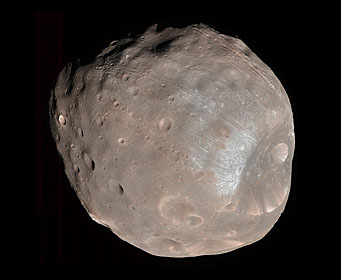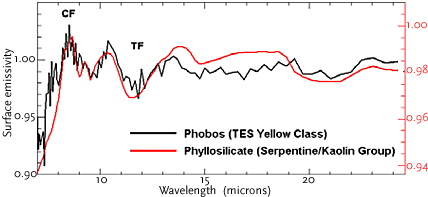Asaph Hall's discovery of Mars's two small moons in 1878 is one of the greatest success stories of observational astronomy. For nearly a century thereafter, however, Phobos and Deimos were little more than dynamical curiosities that traveled oh-so-close to their parent planet.

NASA's Mars Reconnaissance Orbiter captured this view of the Martian moon Phobos on March 23, 2008, from a distance of about 4,200 miles. It's actually a false-color view, combining data from the camera's blue-green, red, and near-infrared channels.The smallest resolved features are about 65 feet across. Click here for a larger version.
NASA / JPL / Univ. of Arizona
With the Space Age came the opportunity to see these objects at closer range, and a succession of spacecraft (beginning with Mariner 9 in 1971) has revealed Deimos and especially Phobos with ever-greater detail. Some particularly dramatic views have come from the HiRISE camera aboard Mars Reconnaissance Orbiter.
Yet, despite decades of careful scrutiny from space and from ground-based telescopes, astronomers still debate where these little worlds came from. They're very dark, implying a carbon-rich composition akin to bodies at the outer margins of the asteroid belt. Both also have a low density, suggesting they're riddled with internal cavities. All this evidence points to the notion that Mars somehow captured a couple of wandering objects that happened to stray too close by. (One big "gotcha": both moons have extremely circular orbits very close to Mars's equatorial plane — not exactly the outcome you'd get from two random encounters.)
Now a team of observers has stirred up the pot of possibilities. Yesterday, at the European Planetary Science Congress in Rome, hometown researcher Marco Giuranna (IFSI/INAF) argued that far-infrared spectra of Phobos acquired with the Mars Express orbiter don't match the composition of any known chondritic asteroid or meteorite type. (Chondrites are rocky bodies that have remained unaltered since the solar system's formation.)

As seen by a spectrometer aboard the Mars Express orbiter, the thermal-infrared spectrum of Phobos is a close match to certain phyllosilicates (clay minerals). Also, the position of the peak labeled CF suggests a composition rich in ultramafic (iron- and magnesium-rich) minerals.
M. Giuranna & others
What he and others have found instead is a distinct composition rich in dark ultramafic minerals (having lots of iron and magnesium) and clay minerals, called phyllosilicates. The clay signature appears strongest near the large crater Stickney, hinting that deposits were dredged up from deeper down.
Moreover, Martin Pätzold (Köln University) also announced at the ESPC that Phobos has a density of just 1.86 ±0.02 g/cm3. To be so low, the moon's interior must be incredibly porous, with voids taking up 25% to 35% of the total volume. The new density value is based on careful tracking of Mars Express during close flybys of Phobos, including a brush-by just 42 miles (67 km) away last March 3rd.
That mix of clay and ultramafic minerals might be rare among the asteroids, but it's likely a lot more common on the Martian surface down below. The upshot, Giuranna suggests, is that Phobos wasn't captured but more likely formed in place from debris blasted off the surface of Mars during a large, long-ago collision. Most of the debris would have escaped to interplanetary space, but enough of it (11 trillion tons, more or less) hung around to recollect into the two Martian moons.
It's a dramatic hypothesis, to be sure, but is it the correct one? First, as Giuranna's team points out, the new compositional clues don't rule out that Phobos (and Deimos) were captured. Observers have found plenty of asteroids with clay minerals on their surfaces, and ultramafic meteorites (achondrites) aren't exactly rare. Second, the moons' spongy interiors could have resulted if a single body broke apart during its capture by Mars and then then reassembled into a pair of not-quite-solid satellites. Finally, someone needs to run a computer simulation to see if this smash-and-dash scenario makes dynamical sense (according to impact modeler Robin Canup, no one's done it yet).
You can reach your own conclusion: the press release announcing the new Mars Express results is here, and more detailed grist is here.
In any case, we might not have to wait too long to learn the Martian moons' pedigree. A Russian mission called Phobos-Grunt is being readied for launch late next year. The effort has encountered technical problems — it was supposed to head off toward Mars a year ago — but if it succeeds, scientists will have 100 to 200 grams of Phobos to analyze when the sample-return capsule lands in July 2014.
 9
9
Comments
Wayne Wooten
September 21, 2010 at 11:47 am
May I suggest the Hellas basin as the event that might have blown up enough of the martian surface to make Phobos? Certainly one of the largest and most striking impact basins preserved anywhere in the solar system.
You must be logged in to post a comment.
Sam.G
September 21, 2010 at 6:30 pm
100 to 200 grams of Phobos to analyze when the sample-return capsule lands in July 2014.
I pray to god safe return mission with martian sample 2014
Sam.G
pownambal's
Space Research Center of Madras
India
You must be logged in to post a comment.
Stefan G.
September 21, 2010 at 9:35 pm
If it turns out the Martian moons were created in a collision (similar to our own moons creation)then that would be the second time in the same solar system it has happen, and if life as we know it requires the changing forces of the moon (tides)than shouldn't earth like planets else where if found have a more probably chance of having a moon. Interesting to see how this turns out but this is what first crossed my mind 😀
You must be logged in to post a comment.
Martin L
September 22, 2010 at 2:28 am
A close look at the striations (fractures) emanating from Stickney show they look clean and straight at first then further out toward the terminator morph into what appears to be crater chains like those seen on other moons. However I wonder, rather than impact debris falling in neat lines smack into the striations (unlikely) they may instead be "sand funnels" where regolith drops into some of the pores beneath the crust. I've play with enough sand at the beach to have created similar sand funnels with my hands.
You must be logged in to post a comment.
Stan Kerns
September 24, 2010 at 2:24 pm
If Phobos is really that porous would not ever the weak gravity it has--PLUS the tugging an pulling exerted by Mars--have worked it into a sphere?
You must be logged in to post a comment.
Dan Skadal
September 24, 2010 at 5:49 pm
If your read Gulivers Travels by Jonathan Swift he describes the 2 moons of Mars with more than interesting detail. He wrote it in 1726. How did he know the detail he wrote abot with such accuracy?
You must be logged in to post a comment.
Michael C. Emmert
September 24, 2010 at 6:37 pm
@Wayne Wooten; Hi 😀
In addition to the large Hellas basin is the nearly-as-large Argyle basin. I would suggest these are the impact sites of Sun/Mars L4 and L5 objects. There are lots of impact basins in the Solar system, especially on the moons of the gas giants. Mars, of course, being a planet, would have larger Lagrangoids and therefore larger impact basins. Don't forget the striking Caloris basin on Mercury.
You must be logged in to post a comment.
sailair
September 25, 2010 at 12:23 am
The Geophysical Research Letters report referenced states, "We conclude that the interior of Phobos likely contains large voids."
Could the density be explained by a multitude of small voids? With the low gravity, something similar to packed sand with a hardened outer crust comes to mind.
You must be logged in to post a comment.
Martin George
September 26, 2010 at 6:49 pm
Just a small correction: Phobos and Deimos were discovered in 1877, not 1878.
You must be logged in to post a comment.
You must be logged in to post a comment.